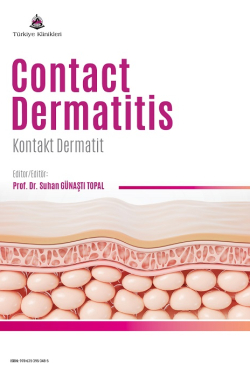Systemic Contact Dermatitis
Leyla BAYKAL SELÇUKa , Ali Osman METİNTAŞa
aKaradeniz Technical University Faculty of Medicine, Department of Dermatology, Trabzon, Türkiye
Baykal Selçuk L, Metintaş AO. Systemic contact dermatitis. In: Günaştı Topal S, ed. Contact Dermatitis. 1st ed. Ankara: Türkiye Klinikleri; 2024. p.32-8.
ABSTRACT
Systemic contact dermatitis is a clinical condition characterized by a delayed-type (type 4) hypersensitivity reaction that develops in individuals previously sensitized to an allergen through the skin, following systemic re-exposure. Systemic contact dermatitis consists of subgroups with similar pathophysiologies. The precise mechanism underlying systemic contact dermatitis reactions has not yet been clearly defined. The disease can be triggered by a wide variety of plants, foods, metals, and medications. Patch testing with suspected agents is recommended for patients who achieve remission after necessary treatment. The primary approach to systemic contact dermatitis treatment is identifying and eliminating the causative allergen. After discontinuing contact with the culprit allergen, skin findings typically regress with desquamation within a few weeks.
Keywords: Contact dermatitis, systemic; patch tests; metal; dermatitis, allergic contact
Kaynak Göster
Referanslar
- Baruffi FY, Venkatesh KP, Nelson KN, Powell A, Santos DM, Ehrlich A. Systemic Contact Dermatitis: A review. Dermatol Clin. 2020;38(3):379-88. [Crossref]
- Aquino M, Rosner G. Systemic Contact Dermatitis. Clin Rev Allergy Immunol. 2019;56(1):9-18. [Crossref]
- Nakayama H, Niki F, Shono M, Hada S. Mercury exanthem. Contact Dermatitis. 1983;9(5):411-7. [Crossref]
- Andersen KE, Hjorth N, Menné T. The baboon syndrome: systemically-induced allergic contact dermatitis. Contact Dermatitis. 1984;10(2):97-100. [Crossref]
- Miyahara A, Kawashima H, Okubo Y, Hoshika A. A new proposal for a clinical-oriented subclassification of baboon syndrome and a review of baboon syndrome. Asian Pac J Allergy Immunol. 2011;29(2):150-60.
- Häusermann P, Harr T, Bircher AJ. Baboon syndrome resulting from systemic drugs: is there strife between SDRIFE and allergic contact dermatitis syndrome? Contact Dermatitis. 2004;51(5-6):297-310. [Crossref]
- Ozkaya E. Current understanding of baboon syndrome. Expert Rev Dermatol. 2009;4(2):163-75. [Crossref]
- Rundle CW, Machler BC, Jacob SE. Pathogenesis and causations of systemic contact dermatitis. G Ital Dermatol Venereol. 2019;154(1):42-9. [Crossref]
- Lampel H, Silvestri D. Systemic contact dermatitis: current challenges and emerging treatments. Curr Treat Options Allergy 2014;1(4):348-57. [Crossref]
- Winnicki M, Shear NH. A systematic approach to systemic contact dermatitis and symmetric drug-related intertriginous and flexural exanthema (SDRIFE): a closer look at these conditions and an approach to intertriginous eruptions. Am J Clin Dermatol. 2011;12(3):171-80. [Crossref]
- Kulberg A, Schliemann S, Elsner P. Contact dermatitis as a systemic disease. Clin Dermatol. 2014;32(3):414-9. [Crossref]
- Pan Z, Yang Y, Zhang L, Zhou X, Zeng Y, Tang R, et al. Systemic Contact Dermatitis: The Routes of Allergen Entry. Clin Rev Allergy Immunol. 2021;61(3):339-350. [Crossref]
- Aquino M, Mucci T. Systemic contact dermatitis and allergy to biomedical devices. Curr Allergy Asthma Rep. 2013;13(5):518-27. [Crossref]
- Honari G, Ellis SG, Wilkoff BL, Aronica MA, Svensson LG, Taylor JS. Hypersensitivity reactions associated with endovascular devices. Contact Dermatitis. 2008;59(1):7-22. [Crossref]
- Fabbro SK, Zirwas MJ. Systemic contact dermatitis to foods: nickel, BOP, and more. Curr Allergy Asthma Rep. 2014;14(10):463. [Crossref]
- Cho E, Lee JD, Cho SH. Systemic contact dermatitis from propolis ingestion. Ann Dermatol. 2011;23(1):85-8. [Crossref]
- Dejobert Y, Delaporte E, Piette F, Thomas P. Vesicular eczema and systemic contact dermatitis from sorbic acid. Contact Dermatitis. 2001;45(5):291. [Crossref]
- de Groot AC. Systemic allergic dermatitis (systemic contact dermatitis) from pharmaceutical drugs: A review. Contact Dermatitis. 2022 Mar;86(3):145-64. [Crossref]
- Bovyat A. Sistemik kontakt dermatit. Turkiye Klinikleri J Dermatol-Special Topics 2011;4(1): 33-40.
- Yaylı S, Bahadır S. Sistemik kontakt dermatit. Türkiye Klinikleri J Dermatol-Special Topics 2008;1(1):103-6.
- Barbaud A, Gonçalo M, Bruynzeel D, Bircher A; European Society of Contact Dermatitis. Guidelines for performing skin tests with drugs in the investigation of cutaneous adverse drug reactions. Contact Dermatitis. 2001;45(6):321-8. [Crossref]
- Fonacier L, Noor I. Contact dermatitis and patch testing for the aller-gist. Ann Allergy Asthma Immunol. 2018;120(6):592-8. [Crossref]
- Fischer T, Rystedt I. False-positive, follicular and irritant patch test reactions to metal salts. Contact Dermatitis. 1985;12(2):93-8. [Crossref]
- Mansfield LE, Urrea L, Hutteman HR. Tolerance to cobalt after immunotherapy for cobalt hypersensitivity. Ann Allergy Asthma Immunol. 2012;108(5):382-3. [Crossref]
- Matiz C, Jacob SE. Systemic contact dermatitis in children: how an avoidance diet can make a difference. Pediatr Dermatol. 2011;28(4):368-74. [Crossref]
- Herro EM, Jacob SE. Systemic contact dermatitis--kids and ketchup. Pediatr Dermatol. 2013;30(3):e32-3. [Crossref]

